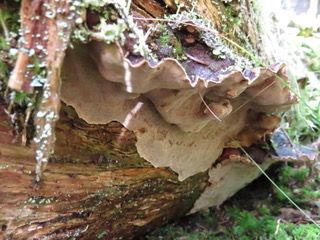
Image Credit: Sundy Maurice
In the project “1KFG: Deep Sequencing of Ecologically-relevant Dikarya” (CSP1974), we aim to sequence additional sampling of genomic diversity within keystone lineages of plant-interacting fungi and saprophytic fungi that are of special ecological importance for understanding terrestrial ecosystems. In addition, comparative genome analysis with saprotrophic, mycorrhizal and pathogenic fungi will provide new insights into the specific and conserved adaptations associated with each fungal lifestyle.
In Fennoscandia, the populations of wood decomposing fungus Phellopilus nigrolimitatus (= Phellinus nigrolimitatus (Romell) Bourdot & Galzin) are dramatically impacted by forest fragmentation and measures that decrease dead wood availability (Kauserud H. & Schumacher 2002, Stokland J. & Kauserud H. 2004), resulting in the species receiving a red list category. It is an old-growth forest species, typically fruiting on advanced decayed conifer logs. The fruit bodies, located mainly underneath of the logs, are perennial, grow large in size and darken in colour with age. The species causes characteristic white pocket rot resulting in interspersed pockets of delignified wood. The hyphal system is indistinctly dimitic or trimitic, septate without clamp connection. Thin-walled basidiospores are narrowly obclavate 7-10 x 2-2.5 µm. For long grouped in the genus Phellinus, its classification was recently revisited and was transferred to a monotypic genus Phellopilus. The sequenced strain has been provided by Dr. Sundy Maurice and Prof. Håvard Kauserud from the University of Oslo.
The availability of a reference genome will support ongoing population genomics studies at both local (forest) and broader European scales (Norway, Sweden, Finland, Russia and Poland) using RADseq and re-sequencing. P. nigrolimitatus harbours a large amount of genetic variation and an impressively high diversity of vegetative compatibility groups (VCGs). An interesting characteristic of the species is that individual VCGs appear to have distinct morphologies in laboratory cultures. The reason behind VCGs revealing unique phenotypes in culture, still unclear in fungi, will be investigated. These different aspects being highly relevant to conservation biology, it is therefore important to investigate and determine the species’ dispersal capabilities. Together with the genomes of Phellinus viticola and Phellinidium ferrugineofuscus, the genome of Phellopilus will be used for improving Hymenochetales phylogenetics (Niemela et al., 2001).
The 1KFG project is a large collaborative effort aiming for master publication(s). Please do contact the PI associated with unpublished 1KFG genomes for permission prior to the use of any data in publications.
References
- Kauserud H. & Schumacher T. (2002) Population structure of the endangered wood decay fungus Phellinus nigrolimitatus (Basidiomycota). Can J Bot 80, 597-606.
- Niemela T., Wagner T., Fischer M. & Dai Y. C. (2001) Phellopilus gen. nov. and its affinities within Phellinus s. lato and Inonotus s. lato (Basidiomycetes). Annales Botanici Fennici 38, 51-62.
- Stokland J. & Kauserud H. (2004) Phellinus nigrolimitatus - a wood-decomposing fungus highly influenced by forestry. Forest Ecol Manag 187, 333-343.
Genome Reference(s)
Sønstebø JH, Trucchi E, Nordén J, Skrede I, Miettinen O, Haridas S, Pangilinan J, Grigoriev IV, Martin F, Kauserud H, Maurice S
Population genomics of a forest fungus reveals high gene flow and climate adaptation signatures.
Mol Ecol. 2022 Apr;31(7):1963-1979. doi: 10.1111/mec.16369
